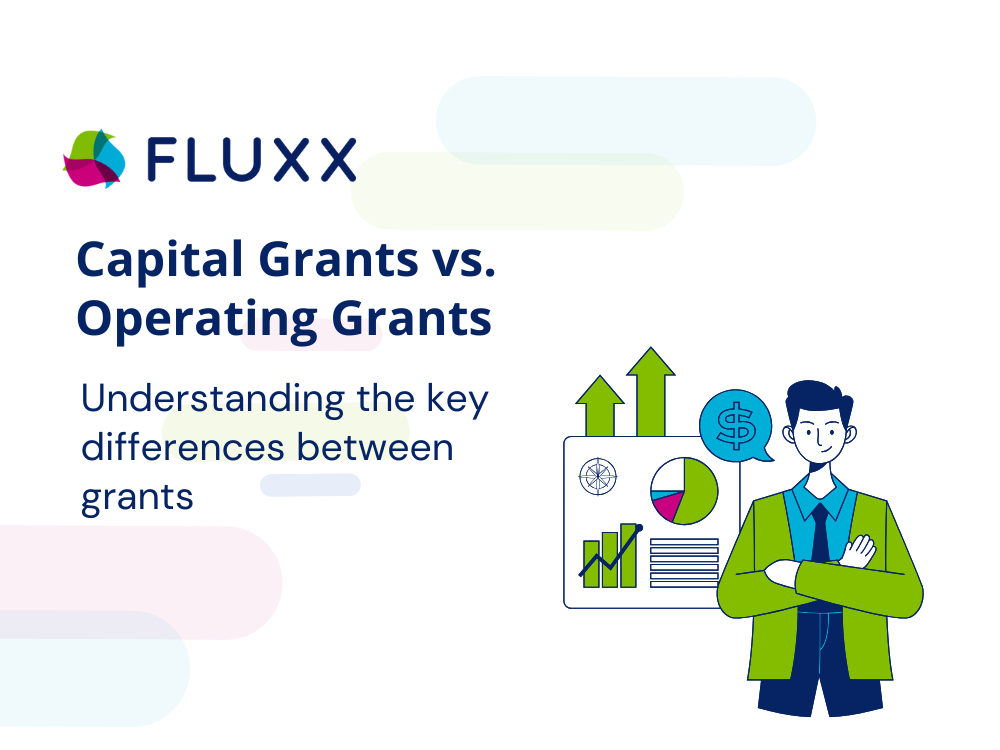What is Grants.gov and How Do I Use It?
Discover what Grants.gov is, how it works, the types of grants available, and how to use the platform effectively. Learn how Fluxx integrates with...
Be the first to know about new Fluxx grants management resources, blog articles and podcasts.


Grant funding is one of the most vital lifelines for nonprofit organizations. Yet not all grants are the same—and understanding the distinction between capital and operating grants is essential for both effective fundraising and strategic financial planning. These two categories serve very different purposes, and both require thoughtful management to ensure compliance, impact, and long-term sustainability.
While capital grants provide funds for infrastructure, equipment, or one-time purchases, operating grants offer the flexibility to support your organization’s ongoing programs and day-to-day costs. Recognizing the differences can help your team apply more strategically and allocate resources more efficiently.
This blog outlines the core definitions, use cases, and management needs for each type—and explains how solutions like Fluxx help nonprofits handle both seamlessly.
Capital grants are funds awarded for the acquisition, improvement, or construction of physical assets. These grants typically support long-term investments that increase your organization’s capacity or service footprint.
Common uses of capital grant funding include:
Capital grants are often larger, one-time awards and come with highly specific usage restrictions. Funders usually require clear documentation, timelines, and project milestones—often demanding architectural plans, bids, permits, or progress reports.
Because of their scale and specificity, capital grants require careful budget forecasting, compliance monitoring, and post-award tracking to ensure that funds are used exactly as intended.
Operating grants, also referred to as general operating support or unrestricted grants, provide funding for your organization’s ongoing activities and administrative needs. These are the lifeblood of nonprofit stability, offering the flexibility to cover everyday expenses.
Operating grants can be used for:
Because they are unrestricted (or lightly restricted), operating grants are especially valuable in times of economic uncertainty or organizational transition. They support the behind-the-scenes functions that keep programs running, yet they are often more competitive to obtain due to the funder’s trust-based nature.
Funders offering operating support often look for well-managed organizations with clear outcomes, mission alignment, and demonstrated financial stewardship.
Although both capital and operating grants support nonprofit work, their core distinctions impact how they are applied for, administered, and reported.
|
Feature |
Capital Grants |
Operating Grants |
|
Purpose |
One-time investments in assets or infrastructure |
Ongoing programmatic and administrative support |
|
Restrictions |
Highly restricted; funds must be used for designated capital project |
Often unrestricted or broadly designated |
|
Typical Grant Size |
Larger, project-based |
Smaller to mid-sized, recurring |
|
Application Process |
May require detailed architectural, engineering, or bidding documentation |
Focuses on mission alignment, outcomes, and sustainability |
|
Reporting Requirements |
Milestone-based progress updates, receipts, asset ownership documentation |
May include outcome measurement, budget reports, or narrative updates |
|
Use Case |
Buying a building, building out a community center, purchasing a mobile clinic |
Running programs, paying salaries, covering rent, covering fundraising expenses |
Understanding these differences enables nonprofits to tailor their grant strategy, meet funder expectations, and diversify income in sustainable ways.
To illustrate the practical applications, here are examples of each type of grant in action:
Both types of grants are critical for organizational health—capital for growth, operating for resilience.
Regardless of the type of grant, proper management is essential to compliance and long-term sustainability. That’s where grant management software like Fluxx makes a difference.
Fluxx is built to manage both capital and operating grants with precision and flexibility—supporting every phase of the grant lifecycle, including:
Fluxx eliminates confusion, prevents errors, and gives your organization the transparency needed to prove impact and build trust with funders—no matter the grant structure.
Capital and operating grants are both crucial—but require different strategies, timelines, and management tools. Knowing how to plan for, pursue, and implement each ensures your nonprofit can grow infrastructure while maintaining the operational capacity to deliver results.
Whether you're managing a building campaign or sustaining your core programs, tools like Fluxx grant management software empower your team to align mission, funding, and compliance in one place.
Ready to see how Fluxx can simplify your capital and operating grant tracking? Book a demo today.
Discover what Grants.gov is, how it works, the types of grants available, and how to use the platform effectively. Learn how Fluxx integrates with...
Explore how grants for religious organizations differ, who qualifies for them, and how grant management software like Fluxx simplifies their...
Explore what a formula grant is, how it works, and how to manage it effectively. Learn how formula grants compare to other types of grants and how...
Be the first to know about new Fluxx grants management resources, blog articles and podcasts.